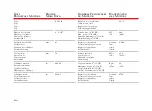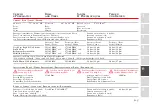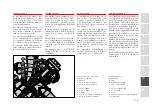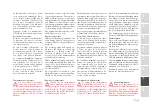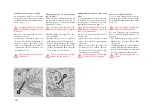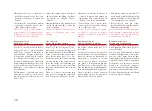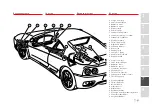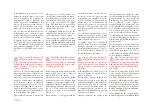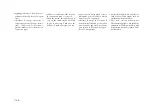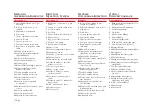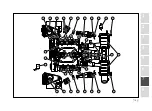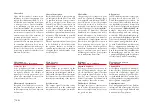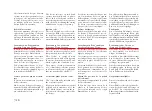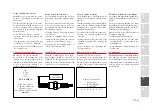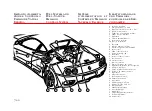
7.8
• Riavviare il motore e verificare il
livello dal tappo di carico
(D)
come
descritto al capitolo “V
ERIFICA
DEI
L
IVELLI
”.
• Verificare che non risultino perdite
attraverso i tappi di scarico
(A)
e
(B)
e dalla cartuccia filtro.
Nel caso si voglia procedere alla so-
stituzione dell’olio e alla pulizia del-
le tubazioni, occorre rivolgersi pres-
so la R
ETE
A
SSISTENZA
F
ERRARI
.
• Remettre en marche le moteur et
contrôler le niveau du bouchon de
remplissage
(D)
comme décrit au
chapitre “C
ONTRÔLE
DES
N
IVEAUX
”.
• Contrôler qu’il n’y a pas de fuites
au niveau des bouchons de vidange
(A)
et
(B)
et du filtre.
Au cas on l’on souhaiterait rempla-
cer l’huile et nettoyer les tuyaux,
s’adresser au R
ESEAU
D’
ASSISTANCE
F
ERRARI
.
• Den Motor anlassen und den Öl-
stand durch den Einfüllstopfen
(D)
gemäß den Hinweisen von Kapitel
“Ö
LSTANDSKONTROLLE
” prüfen.
• Kontrollieren, daß die Ölab-
lassschrauben
(A)
und
(B)
und der
Filtereinsatz dicht sind.
Soll ein Ölwechsel und die Reinigung
der Leitungen vorgenommen werden,
ist es ratsam, sich an einen F
ERRARI
-
K
UNDENDIENST
zu wenden.
• Start the engine again and check
the level from the filling cap
(D)
as
described in chapter “L
EVEL
C
HECKS
”.
• Ensure that there is no leakage from
drain caps
(A)
and
(B)
or from
the
filter cartridge.
Contact the F
ERRARI
A
SSISTANCE
N
ET
-
WORK
for oil changes and oil line
cleaning.
Ricircolo Gas e
Vapori di Olio
Il dispositivo di circolazione dei gas e
vapori olio è del tipo a circuito chiuso.
I vapori di olio e i gas provenienti
dalle teste, vengono convogliati in
una tubazione collegata al separato-
re vapori; da qui, una parte conden-
sa e defluisce nel serbatoio olio sot-
tostante. I rimanenti gas, grazie alla
depressione generata dal motore, ven-
gono aspirati attraverso i tubi di col-
legamento e convogliati ai polmoni
di aspirazione.
Nell’impianto è presente una tuba-
zione che provvede a scaricare accu-
muli di pressione all’interno del ser-
batoio olio.
Gas and Oil
Vapour Re-circulation
The gas and oil vapour circulation
device is of the closed circuit type.
Gases and oil vapour coming from
the cylinder heads are channelled into
a line connected to the vapour sepa-
rator. From there, part of it con-
denses and flows into the underlying
oil tank. Owing to the vacuum creat-
ed by the engine, the remaining gas-
es are taken up by the connecting
lines and channelled to the plenum
chambers.
There is a line in the system that
provides for releasing the accumula-
tion of pressure inside the oil tank.
Recirculation du
Gaz et Vapeurs d’Huile
Ce système de circulation des gaz et
des vapeurs d’huile est de type à cir-
cuit fermé.
Les vapeurs d’huile et des gaz émis
par les culasses sont envoyés dans un
tuyau au système de reniflard d’où
une partie se condense et s’écoule
vers le réservoir d’huile. Les autres
gaz,
grâce à la dépression générée
par le moteur, sont aspirés à tra-
vers les tuyaux de branchement et
envoyés aux poumons d’aspiration.
Dans le système se trouve un tuyau
qui décharge les pics de pression à
l’intérieur du réservoir d’huile.
Rückführung von
Gasen und Öldämpfen
Das Rückführsystem für Kraftstoff-
und Öldämpfe bildet einen geschlos-
senen Kreislauf.
Die von den Zylinderköpfen kom-
menden Öldämpfe und Gase gelan-
gen über eine eigene Leitung zum
Ölabscheider; hier kondensiert ein Teil
und fließt in den darunter liegenden
Ölbehälter. Die Restgase werden
durch den vom Motor erzeugten
Unterdruck über die Anschlussleitun-
gen zu den Ansaugtrakten geleitet.
Für den Druckausgleich im Öltank
sorgt eine eigene Leitung.
Summary of Contents for 2000 360 Modena
Page 1: ......
Page 2: ......
Page 8: ...8 Indice Summary Sommaire Inhaltsverzeichnis ...
Page 260: ......

